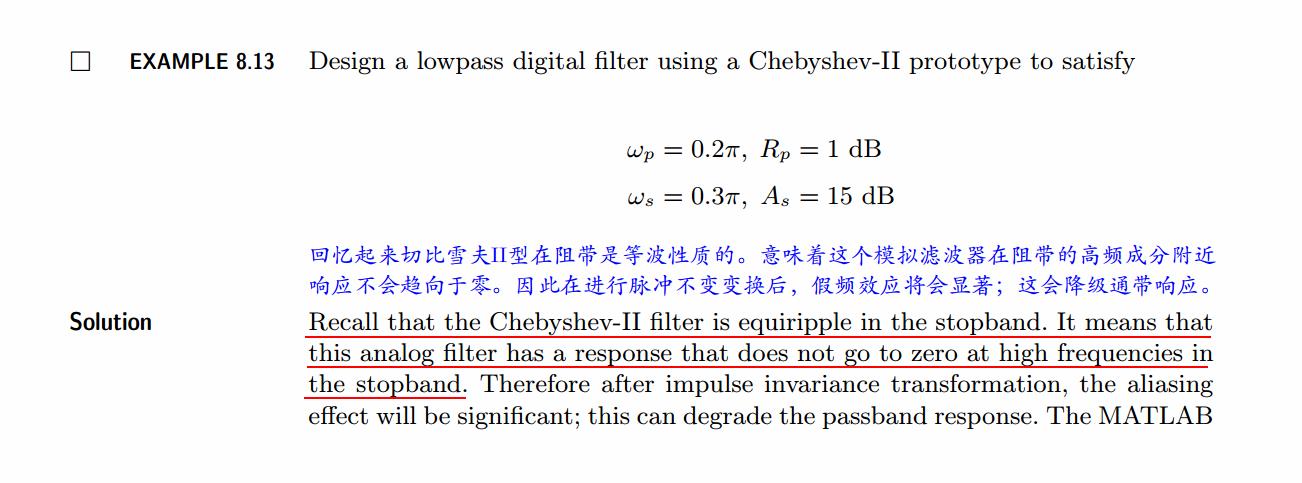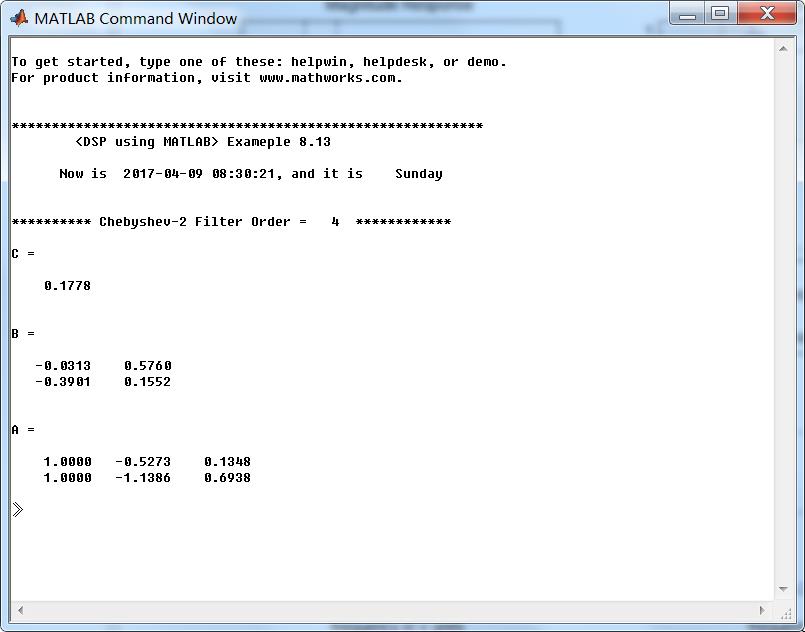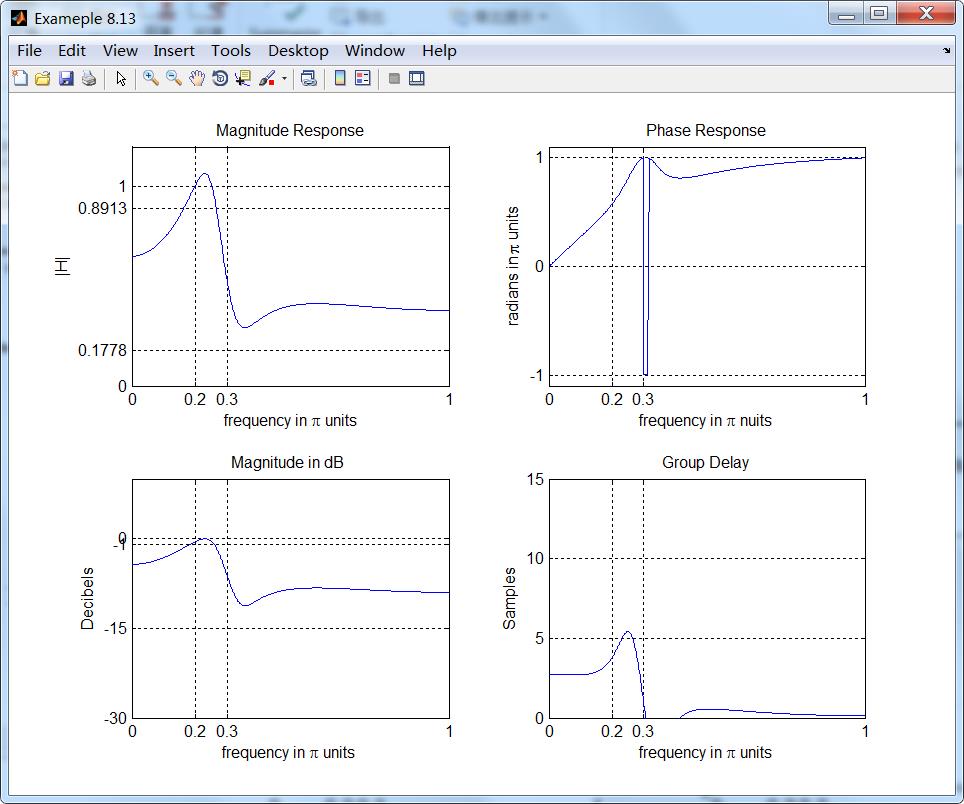《DSP using MATLAB》示例Example 8.13
Posted 沧海一粟
tags:
篇首语:本文由小常识网(cha138.com)小编为大家整理,主要介绍了《DSP using MATLAB》示例Example 8.13相关的知识,希望对你有一定的参考价值。

%% ------------------------------------------------------------------------
%% Output Info about this m-file
fprintf(\'\\n***********************************************************\\n\');
fprintf(\' <DSP using MATLAB> Exameple 8.13 \\n\\n\');
time_stamp = datestr(now, 31);
[wkd1, wkd2] = weekday(today, \'long\');
fprintf(\' Now is %20s, and it is %8s \\n\\n\', time_stamp, wkd2);
%% ------------------------------------------------------------------------
% Digital Filter Specifications:
wp = 0.2*pi; % digital passband freq in rad
ws = 0.3*pi; % digital stopband freq in rad
Rp = 1; % passband ripple in dB
As = 15; % stopband attenuation in dB
% Analog prototype specifications: Inverse Mapping for frequencies
T = 1; % set T = 1
OmegaP = wp/T; % prototype passband freq
OmegaS = ws/T; % prototype stopband freq
% Analog Chebyshev-2 Prototype Filter Calculation:
[cs, ds] = afd_chb2(OmegaP, OmegaS, Rp, As);
% Impulse Invariance Transformation:
[b, a] = imp_invr(cs, ds, T); [C, B, A] = dir2par(b, a)
% Calculation of Frequency Response:
[db, mag, pha, grd, ww] = freqz_m(b, a);
%% -----------------------------------------------------------------
%% Plot
%% -----------------------------------------------------------------
figure(\'NumberTitle\', \'off\', \'Name\', \'Exameple 8.13\')
set(gcf,\'Color\',\'white\');
M = 1; % Omega max
subplot(2,2,1); plot(ww/pi, mag); axis([0, M, 0, 1.2]); grid on;
xlabel(\' frequency in \\pi units\'); ylabel(\'|H|\'); title(\'Magnitude Response\');
set(gca, \'XTickMode\', \'manual\', \'XTick\', [0, 0.2, 0.3, M]);
set(gca, \'YTickMode\', \'manual\', \'YTick\', [0, 0.1778, 0.8913, 1]);
subplot(2,2,2); plot(ww/pi, pha/pi); axis([0, M, -1.1, 1.1]); grid on;
xlabel(\'frequency in \\pi nuits\'); ylabel(\'radians in \\pi units\'); title(\'Phase Response\');
set(gca, \'XTickMode\', \'manual\', \'XTick\', [0, 0.2, 0.3, M]);
set(gca, \'YTickMode\', \'manual\', \'YTick\', [-1:1:1]);
subplot(2,2,3); plot(ww/pi, db); axis([0, M, -30, 10]); grid on;
xlabel(\'frequency in \\pi units\'); ylabel(\'Decibels\'); title(\'Magnitude in dB \');
set(gca, \'XTickMode\', \'manual\', \'XTick\', [0, 0.2, 0.3, M]);
set(gca, \'YTickMode\', \'manual\', \'YTick\', [-30, -15, -1, 0]);
subplot(2,2,4); plot(ww/pi, grd); axis([0, M, 0, 15]); grid on;
xlabel(\'frequency in \\pi units\'); ylabel(\'Samples\'); title(\'Group Delay\');
set(gca, \'XTickMode\', \'manual\', \'XTick\', [0, 0.2, 0.3, M]);
set(gca, \'YTickMode\', \'manual\', \'YTick\', [0:5:15]);
运行结果:


从图中看出,通带和阻带响应都有所降级,因此脉冲不变设计方法不能够得到所需要的数字滤波器。
以上是关于《DSP using MATLAB》示例Example 8.13的主要内容,如果未能解决你的问题,请参考以下文章
《DSP using MATLAB》示例Example 6.20
《DSP using MATLAB》示例Example5.17
《DSP using MATLAB》示例Example5.18
《DSP using MATLAB》示例Example5.21